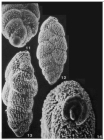Foraminifera taxon details
Spiroloxostoma Conato, 1964 †
465904 (urn:lsid:marinespecies.org:taxname:465904)
accepted
Genus
Spiroloxostoma croarae Conato, 1964 † (type by original designation)
Vsevolodia Kantorová, 1975 † · unaccepted (Subjective junior synonym in...)
Subjective junior synonym in opinion of Loeblich and Tappan (1987)
- Species Spiroloxostoma croarae Conato, 1964 †
- Species Spiroloxostoma czechoviczi (Kantorová, 1975) †
- Species Spiroloxostoma maghrebensis Barbieri, 1997 †
- Species Spiroloxostoma savenae Conato, 1964 †
- Species Spiroloxostoma glabra (Millett, 1903) accepted as Hopkinsinella glabra (Millett, 1903) (Opinion of Revets, 1996)
marine, brackish, fresh, terrestrial
fossil only
neuter
Conato, V. (1964). Alcuni foraminiferi nuovi nel Pliocene Nordappenninico, Contributo I. <em>Geologica Romana.</em> 3: 279-302., available online at http://www.dst.uniroma1.it/geologicaromana/Volumi/VOL%203/GR_3%20%20279%20-%20295_Conato.pdf
page(s): p. 284 [details] Available for editors [request]
[request]
page(s): p. 284 [details] Available for editors
Diagnosis Test small, elongate, oval in section, proloculus large, globular, chambers in a twisted biserial arrangement, early ones...
Diagnosis Test small, elongate, oval in section, proloculus large, globular, chambers in a twisted biserial arrangement, early ones broad and low, increasing in height as added, final chamber tending to become terminal and produced, sutures oblique, depressed; wall calcareous, optically radial, finely and densely perforate, surface ornamented by short longitudinally aligned irregular ridges and nodes; aperture in the early stage an arch at the base of the chamber with a small lip at one margin, later becoming circular and areal and finally terminal, bordered by a lip and with a projecting tooth, internally the toothplate forms a narrow ridge running along the inside of the chamber wall to connect successive foramina. L. Miocene to L. Pliocene; Italy; Czechoslovakia. (Loeblich & Tappan, 1987, Foraminiferal Genera and Their Classification) [details]
Hayward, B.W.; Le Coze, F.; Vachard, D.; Gross, O. (2025). World Foraminifera Database. Spiroloxostoma Conato, 1964 †. Accessed at: https://www.marinespecies.org/Foraminifera/aphia.php?p=taxdetails&id=465904 on 2025-05-04
Date
action
by
original description
Conato, V. (1964). Alcuni foraminiferi nuovi nel Pliocene Nordappenninico, Contributo I. <em>Geologica Romana.</em> 3: 279-302., available online at http://www.dst.uniroma1.it/geologicaromana/Volumi/VOL%203/GR_3%20%20279%20-%20295_Conato.pdf
page(s): p. 284 [details] Available for editors [request]
[request]
original description (of Vsevolodia Kantorová, 1975 †) Kantorová, V., 1975, Vsevolodia, a new foraminiferal genus from the Oncophora beds of southern Slovakia, Západné Karpaty, Séria Paleontológia 1:87-92.
page(s): p. 87 [details]
additional source Loeblich, A. R.; Tappan, H. (1987). Foraminiferal Genera and their Classification. Van Nostrand Reinhold Company, New York. 970pp., available online at https://books.google.pt/books?id=n_BqCQAAQBAJ [details] Available for editors [request]
[request]
page(s): p. 284 [details] Available for editors
original description (of Vsevolodia Kantorová, 1975 †) Kantorová, V., 1975, Vsevolodia, a new foraminiferal genus from the Oncophora beds of southern Slovakia, Západné Karpaty, Séria Paleontológia 1:87-92.
page(s): p. 87 [details]
additional source Loeblich, A. R.; Tappan, H. (1987). Foraminiferal Genera and their Classification. Van Nostrand Reinhold Company, New York. 970pp., available online at https://books.google.pt/books?id=n_BqCQAAQBAJ [details] Available for editors
From editor or global species database
Diagnosis Test small, elongate, oval in section, proloculus large, globular, chambers in a twisted biserial arrangement, early ones broad and low, increasing in height as added, final chamber tending to become terminal and produced, sutures oblique, depressed; wall calcareous, optically radial, finely and densely perforate, surface ornamented by short longitudinally aligned irregular ridges and nodes; aperture in the early stage an arch at the base of the chamber with a small lip at one margin, later becoming circular and areal and finally terminal, bordered by a lip and with a projecting tooth, internally the toothplate forms a narrow ridge running along the inside of the chamber wall to connect successive foramina. L. Miocene to L. Pliocene; Italy; Czechoslovakia. (Loeblich & Tappan, 1987, Foraminiferal Genera and Their Classification) [details]

